I am trying to adapt the pie ProgressBar found in the book WPF 4 Unleashed to look like a doughnut. I feel I am half way there but I don't know how to solve the last problem.
Here is a picture illustrating what I want and what I have managed to achieve:
- This is how I want it to look.
- This is what it looks like using the code below.
- I found a suggestion in a different question here at stackoverflow which was to use clipping on the path and double the stroke thickness. As you can see the path is positioned correctly now but any progress below 50% is not drawn correctly as you can see.
So my question is, how can I fix it to look like I want?
Below is the relevant xaml I am using:
<ControlTemplate x:Key="DonutProgressBar" TargetType="{x:Type ProgressBar}">
<ControlTemplate.Resources>
<conv:ValueMinMaxToIsLargeArcConverter x:Key="ValueMinMaxToIsLargeArcConverter" />
<conv:ValueMinMaxToPointConverter x:Key="ValueMinMaxToPointConverter" />
</ControlTemplate.Resources>
<Grid>
<Viewbox>
<Grid Width="20" Height="20">
<Ellipse x:Name="Background"
Stroke="{TemplateBinding BorderBrush}"
StrokeThickness="{Binding RelativeSource={RelativeSource TemplatedParent}, Path=BorderThickness.Top}"
Width="20"
Height="20"
Fill="{TemplateBinding Background}" />
<Path x:Name="Donut"
Stroke="{TemplateBinding Foreground}"
StrokeThickness="{Binding RelativeSource={RelativeSource TemplatedParent}, Path=BorderThickness.Top}">
<Path.Data>
<PathGeometry>
<PathGeometry.Figures>
<PathFigure StartPoint="10,0">
<ArcSegment Size="10,10" SweepDirection="Clockwise">
<ArcSegment.Point>
<MultiBinding Converter="{StaticResource ValueMinMaxToPointConverter}">
<Binding RelativeSource="{RelativeSource TemplatedParent}" Path="Value" />
<Binding RelativeSource="{RelativeSource TemplatedParent}" Path="Minimum" />
<Binding RelativeSource="{RelativeSource TemplatedParent}" Path="Maximum" />
</MultiBinding>
</ArcSegment.Point>
<ArcSegment.IsLargeArc>
<MultiBinding Converter="{StaticResource ValueMinMaxToIsLargeArcConverter}">
<Binding RelativeSource="{RelativeSource TemplatedParent}" Path="Value" />
<Binding RelativeSource="{RelativeSource TemplatedParent}" Path="Minimum" />
<Binding RelativeSource="{RelativeSource TemplatedParent}" Path="Maximum" />
</MultiBinding>
</ArcSegment.IsLargeArc>
</ArcSegment>
</PathFigure>
</PathGeometry.Figures>
</PathGeometry>
</Path.Data>
</Path>
</Grid>
</Viewbox>
</Grid>
</ControlTemplate>
...
<ProgressBar Width="70" Height="70" Value="40" Template="{StaticResource DonutProgressBar}" Background="{x:Null}" BorderBrush="#1F000000" BorderThickness="6,6,1,1" />
...and the converters:
public class ValueMinMaxToPointConverter : IMultiValueConverter
{
public object Convert(object[] values, Type targetType, object parameter, CultureInfo culture)
{
double value = (double)values[0];
double minimum = (double)values[1];
double maximum = (double)values[2];
double current = (value / (maximum - minimum)) * 360;
if (current == 360)
current = 359.999;
current = current - 90;
current = current * (Math.PI / 180.0);
double x = 10 + 10 * Math.Cos(current);
double y = 10 + 10 * Math.Sin(current);
return new Point(x, y);
}
public object[] ConvertBack(object value, Type[] targetType, object parameter, CultureInfo culture)
{
throw new NotSupportedException();
}
}
public class ValueMinMaxToIsLargeArcConverter : IMultiValueConverter
{
public object Convert(object[] values, Type targetType, object parameter, CultureInfo culture)
{
double value = (double)values[0];
double minimum = (double)values[1];
double maximum = (double)values[2];
return ((value * 2) >= (maximum - minimum));
}
public object[] ConvertBack(object value, Type[] targetType, object parameter, CultureInfo culture)
{
throw new NotSupportedException();
}
}





